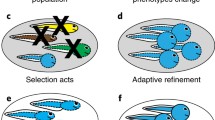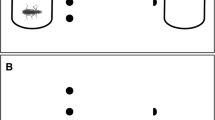Abstract
Polyphenism is the expression of multiple, discrete phenotypes from one genotype, and understanding the environmental factors that trigger development of alternative phenotypes is a critical step toward understanding the evolution of polyphenism and its developmental control. While much is known about the ecology of the well-known carnivore/omnivore polyphenism in spadefoot toad tadpoles, the environmental cues for the development of the specialized carnivore phenotype are not completely clear. We examined 27 different experimental treatments in two spadefoot toad species and used over 1,000 tadpoles in an attempt to elucidate those cues. While only 44 carnivores developed in these treatments, they were concentrated at cooler water temperatures and a diet that included fairy shrimp. However, while a diet of fairy shrimp promoted carnivore development, it was not necessary for inducing carnivore development at lower and intermediate water temperatures. Evidence also suggested a role for social inhibition that limited the proportion of interacting tadpoles that become carnivores. Tadpoles of Spea multiplicata grew larger at cooler temperatures and larger when their diets included fairy shrimp, whereas tadpoles of S. bombifrons grew larger at warmer temperatures and when their diets did not include fairy shrimp. These results indicate that carnivore induction can occur through different cues and that our current model for carnivore development is too limited. Finally, we argue that the carnivore/omnivore spadefoot system is neither a polyphenism nor a polymorphism but is a continuously distributed plasticity.



Similar content being viewed by others
References
Badyaev AV (2005) Stress-induced variation in evolution: from behavioural plasticity to genetic assimilation. Proc R Soc Lond B 272:877–886
Buchholz DR, Hayes TB (2000) Larval period comparison for the spadefoot toads Scaphiopus couchii and Spea multiplicata (Pelobatidae: Anura). Herpetologica 56:455–468
Cain ML, Bowman WD, Hacker SD (2008) Ecology. Sinauer Associates Inc., Sunderland
Evans JD, Wheeler DE (2001) Gene expression and the evolution of insect polyphenisms. BioEssays 23:62–68
Frankino WA, Pfennig DW (2001) Condition-dependent expression of trophic polyphenism: effects of individual size and competitive ability. Evol Ecol Res 3:939–951
Garcia-Paris M, Buchholz DR, Parra-Olea G (2003) Phylogenetic relationships of Pelobatoidea re-examined using mtDNA. Mol Phylogenet Evol 28:12–23
Ghioca-Robrecht DM, Smith LM, Densmore LD (2009) Ecological correlates of trophic polyphenism in spadefoot tadpoles inhabiting playas. Can J Zool 87:229–238
Gilbert SF (2001) Ecological developmental biology: developmental biology meets the real world. Dev Biol 233:1–12
Gilbert SF (2006) Developmental biology, 8th edn. Sinauer Associates Inc., Sunderland
Gomez-Mestre I, Buchholz DR (2006) Developmental plasticity mirrors differences among taxa in spadefoot toads linking plasticity and diversity. Proc Nat Acad Sci USA 103:19021–19026
Gosner KL (1960) A simplified table for staging anuran embryos and larvae with notes on identification. Herpetologica 16:183–190
Greene E (1989) A diet-induced developmental polymorphism in a caterpillar. Science 243:643–646
Hall BK (1998) Evolutionary developmental biology, 2nd edn. Kluwer, Dordrecht
Hall BK, Pearson RD, Muller GB (2003) Environment, development, and evolution: toward a synthesis. MIT Press, Cambridge
Heyland A, Moroz LL (2005) Cross-kingdom hormonal signaling: an insight from thyroid hormone functions in marine larvae. J Exp Biol 208:4355–4361
Kaplan RH, Phillips PC (2006) Ecological and developmental context of natural selection: maternal effects and thermally induced plasticity in the frog Bombina orientalis. Evolution 60:142–156
Ketterson ED, VJr Nolan (1999) Adaptation, exaptation, and constrait: a hormonal perspective. Am Nat 154:S4–S25
Kupferberg SJ (1997) The role of larval diet in anuran metamorphosis. Am Zool 37:146–159
Ledon-Rettig CC, Pfennig DW, Nascone-Yoder N (2008) Ancestral variation and the potential for genetic accommodation in larval amphibians: implications for the evolution of novel feeding strategies. Evol Dev 10:316–325
Leips J, Travis J (1994) Metamorphic responses to changing food levels in two species of hylid frogs. Ecology 75:1345–1356
Leips J, McManus MG, Travis J (2000) Response of tree frog larvae to drying ponds: comparing permanent and temporary pond breeders. Ecology 81:2997–3008
Maleszka R (2008) Epigenetic integration of environmental and genomic signals in honey bees. Epigenetics 3:188–192
Mayr E (1963) Animal species and evolution. Harvard University Press, Cambridge
McDiarmid RW, Altig R (1999) Tadpoles: the biology of anuran larvae. University of Chicago Press, Chicago
Moran NA (1992) The evolutionary maintenance of alternative phenotypes. Am Nat 139:971–989
Morey S, Reznick D (2001) Effects of larval density on postmetamorphic spadefoot toads (Spea hammondii). Ecology 82:510–522
Newman RA (1987) Effects of density and predation on Scaphiopus couchii tadpoles in desert ponds. Oecologia 71:301–307
Nijhout HF (1999) Control mechanisms of polyphenic development in insects. Bioscience 49:181–192
Pfennig DW (1990) The adaptive significance of an environmentally-cued developmental switch in an anuran tadpole. Oecologia 85:101–107
Pfennig DW (1992a) Proximate and functional causes of polyphenism in an anuran tadpole. Funct Ecol 6:167–174
Pfennig DW (1992b) Polyphenism in spadefoot toad tadpoles as a locally adjusted evolutionary stable strategy. Evolution 46:1408–1420
Pfennig DW, Collins JP (1993) Kinship affects morphogenesis in cannibalistic salamanders. Nature 362:836–838
Pfennig DW, Frankino WA (1997) Kin-mediated morphogenesis in facultatively cannibalistic tadpoles. Evolution 51:1993–1999
Pfennig DW, Murphy PJ (2002) How fluctuating competition and phenotypic plasticity mediate species divergence. Evolution 56:1217–1228
Pfennig DW, Rice AM, Martin RA (2006) Ecological opportunity and phenotypic plasticity interact to promote character displacement and species coexistence. Ecology 87:769–779
Pfennig DW, Rice AM, Martin RA (2007) Field and experimental evidence for competition’s role in phenotypic divergence. Evolution 61:257–271
Pigliucci M (2001) Phenotypic plasticity: beyond nature and nurture. Johns Hopkins University Press, Baltimore
Pomeroy LV (1981) Developmental polymorphism in the tadpoles of the spadefoot toad, Scaphiopus multiplicata. Ph.D. dissertation, University of California, Riverside
Rapp RA, Wendel JF (2005) Epigenetics and plant evolution. New Phytol 168:81–91
Rice AM, Pfennig DW (2008) Analysis of range expansion in two species undergoing character displacement: why might invaders generally “win” during character displacement? J Evol Biol 21:696–704
Roff DA (1996) The evolution of threshold traits in animals. Q Rev Biol 71:3–34
Rose CS (2005) Integrating ecology and developmental biology to explain the timing of frog metamorphosis. Trends Ecol Evol 20:129–135
Rudel D, Sommer RJ (2003) The evolution of developmental mechanisms. Dev Biol 264:15–37
Semlitsch RD, Caldwell JP (1982) Effects of density on growth, metamorphosis, and survivorship in tadpoles of Scaphiopus holbrooki. Ecology 63:905–911
Smith TB, Skulason S (1996) Evolutionary significance of resource polymorphisms in fishes, amphibians, and birds. Annu Rev Ecol Syst 27:111–133
Steinwascher K (1979) Competitive interactions among tadpoles—responses to resource level. Ecology 60:1172–1183
Storz BL (2004) Reassessment of the environmental mechanisms controlling developmental polyphenism in spadefoot toad tadpoles. Oecologia 141:402–410
Storz BL, Travis J (2007) Trait-specific and temporally dissociated developmental program modification in Spea multiplicata tadpoles suggests modularity. TSW Dev Embryol 7:715–726
Sultan SS (2007) Development in context: the timely emergence of eco-devo. Trends Ecol Evol 22:575–582
Suzuki Y, Nijhout HF (2006) Evolution of a polyphenism by genetic accommodation. Science 311:650–652
Travis J (1980) Phenotypic variation and the outcome of interspecific competition in hylid tadpoles. Evolution 34:40–50
Travis J (1994) Evaluating the adaptive role of morphological plasticity. In: Wainwright PC, Reilly SM (eds) Ecological morphology: integrative organismal biology. University of Chicago Press, Chicago, pp 99–122
Turner FB (1952) The mouth parts of tadpoles of the spadefoot toad, Scaphiopus hammondi. Copeia 3:172–175
Ultsch GR, Bradford DF, Freda J (1999) Physiology: coping with the environment. In: McDiarmid RW, Altig R (eds) Tadpoles: the biology of anuran larvae. University of Chicago Press, Chicago, pp 24–51
Waldman B (1985) Olfactory basis of kin recognition in toad tadpoles. J Comp Physiol 156:565–577
Waldman B, Bishop PJ (2004) Chemical communication in an archaic anuran amphibian. Behav Ecol 15:88–93
West-Eberhard MJ (2003) Developmental plasticity and evolution. Oxford University Press, New York
Acknowledgments
Many thanks are due to Thomas A. Houpt, J. Michael Overton, P. Bryant Chase, Wu-Min Deng, Anne Thistle, the Moerland laboratory, and four anonymous reviewers for comments and constructive criticism of the manuscript. I also thank the resident scientists, staff, and volunteers at the Southwestern Research Station (American Museum of Natural History). This research was supported by the Theodore Roosevelt Memorial Fund (AMNH), Sigma Xi, and the Robert B. Short Fellowship (FSU). All laboratory research was conducted under ACUC protocol 0020 from Florida State University and collecting permit Arizona SP710791.
Author information
Authors and Affiliations
Corresponding author
Additional information
Communicated by Ross Alford.
Rights and permissions
About this article
Cite this article
Storz, B.L., Heinrichs, J., Yazdani, A. et al. Reassessment of the environmental model of developmental polyphenism in spadefoot toad tadpoles. Oecologia 165, 55–66 (2011). https://doi.org/10.1007/s00442-010-1766-2
Received:
Accepted:
Published:
Issue Date:
DOI: https://doi.org/10.1007/s00442-010-1766-2




